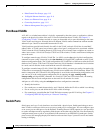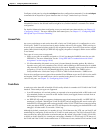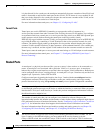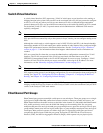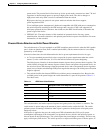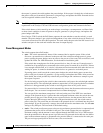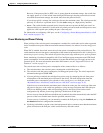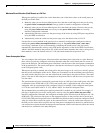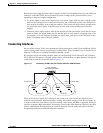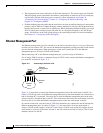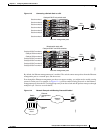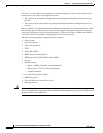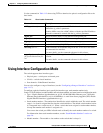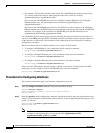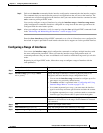
11-10
Catalyst 3750-E and 3560-E Switch Software Configuration Guide
OL-9775-02
Chapter 11 Configuring Interface Characteristics
Understanding Interface Types
Maximum Power Allocation (Cutoff Power) on a PoE Port
When power policing is enabled, the switch determines one of the these values as the cutoff power on
the PoE port in this order:
1. Manually when you set the user-defined power level that the switch budgets for the port by using
the power inline consumption default wattage global or interface configuration command
2. Manually when you set the user-defined power level that limits the power allowed on the port by
using the power inline auto max max-wattage or the power inline static max max-wattage
interface configuration command
3. Automatically when the switch sets the power usage of the device by using CDP power negotiation
or by the IEEE classification
4. Automatically when the switch sets the power usage to be the default value of 15.4 W
Use the first or second method in the previous list to manually configure the cutoff-power value by
entering the power inline consumption default wattage or the power inline [auto | static max]
max-wattage command. If you are not manually configuring the cutoff-power value, the switch
automatically determines the value by using CDP power negotiation or the device IEEE classification,
which is the third method in the previous list. If the switch cannot determine the value by using one of
these methods, it uses the default value of 15.4 W (the fourth method in the previous list).
Power Consumption Values
You can configure the initial power allocation and the maximum power allocation on a port. However,
these values are only the configured values that determine when the switch should turn on or turn off
power on the PoE port. The maximum power allocation is not the same as the actual power consumption
of the powered device. The actual cutoff power value that the switch uses for power policing is not equal
to the configured power value.
When power policing is enabled, the switch polices the power usage at the switch port, which is greater
than the power consumption of the device. When you are manually set the maximum power allocation,
you must consider the power loss over the cable from the switch port to the powered device. The cutoff
power is the sum of the rated power consumption of the powered device and the worst-case power loss
over the cable.
The actual amount of power consumed by a powered device on a PoE port is the cutoff-power value plus
a calibration factor of 500 mW (0.5 W). The actual cutoff value is approximate and varies from the
configured value by a percentage of the configured value. For example, if the configured cutoff power
is 12 W, the actual cutoff-value is 11.4 W, which is 0.05% less than the configured value.
We recommend that you enable power policing when PoE is enabled on your switch. For example, if
policing is disabled and you set the cutoff-power value by using the power inline auto max 6300
interface configuration command, the configured maximum power allocation on the PoE port is 6.3 W
(6300 mW). The switch provides power to the connected devices on the port if the device needs up to
6.3 W. If the CDP-power negotiated value or the IEEE classification value exceeds the configured cutoff
value, the switch does not provide power to the connected device. After the switch turns on power on
the PoE port, the switch does not police the real-time power consumption of the device, and the device
can consume more power than the maximum allocated amount, which could adversely affect the switch
and the devices connected to the other PoE ports.



